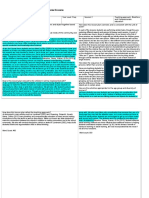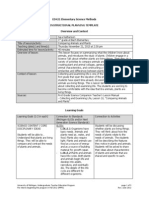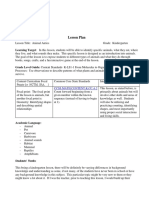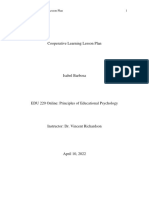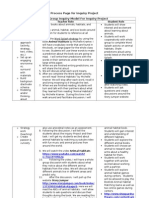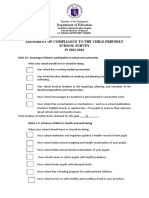Edu 417 WK 4 Reviselessonplan
Edu 417 WK 4 Reviselessonplan
Uploaded by
api-288759469Copyright:
Available Formats
Edu 417 WK 4 Reviselessonplan
Edu 417 WK 4 Reviselessonplan
Uploaded by
api-288759469Original Title
Copyright
Available Formats
Share this document
Did you find this document useful?
Is this content inappropriate?
Copyright:
Available Formats
Edu 417 WK 4 Reviselessonplan
Edu 417 WK 4 Reviselessonplan
Uploaded by
api-288759469Copyright:
Available Formats
Brain-Compatible
Brain-Compatible Lesson Plans
Jennifer Berneche
EDU417
Instructor Lienau
June 28, 2015
Brain-Compatible
Animal Colors and Shapes
Grade Level: Pre-K - K
Objectives
Students will
Understand that animals come in different colors and shapes.
Describe the purposes of color in the animal world.
Use different colors and shapes to create pictures of animals.
Materials
Stuffed animal/puppet, lion. Any type of animal will do.
Animal Colors and Shapes video
Crayons
White construction paper, 1 sheet per student
Print resources with images of different animals
Colored construction paper cut into different sized triangles, circles, squares, and
rhomboids
Glue
Paper plates
Construction paper
Paint
Yarn
Animal crackers
Time: Approximately 45 minutes; Flexible. Adjust time for students with diverse needs.
Procedures
1.
Briefly introduce new vocabulary words: camouflage, colors, purpose, rhomboid, shape.
2.
Use Animals Colors and Shapes to introduce common colors and shapes in the animal
world. After watching the program, ask students to share examples shapes they have seen. What
Brain-Compatible
body part of most animals is circular? What animals have triangles? What animals have
rhomboids? Let out a loud Rrrrrroar! Introduce students to the stuffed lion. Allow them to pet
him. Discuss colors and shapes found on lions. Ask if anyone has ever seen a real lion.
3.
Talk about the students' favorite animals. What colors can be found on them? Discuss
some of the purposes of color in the animal world. Why are the feathers on most male birds
bright colors, while female birds have gray or brown? How do some animals use color to stay
hidden? Why are some snakes brightly colored?
4.
Share print images of animals. Talk about the different colors and shapes of these
animals. Has anyone actually seen some of these animals? Where? Tell students that they are
going to create pictures of animals with different shapes. They will also draw a picture of the
animal's habitat.
5.
Demonstrate using a print image as an example. Talk about the animal. What kind of
environment would you expect to find this animal in? Have students describe where this animal
might live. Does it live in a desert or a forest? Using crayons, quickly draw the environment on a
piece of white construction paper. Next, talk about the different shapes students might see on the
animal. What shape are its ears? What shape is its body? Use different size construction-paper
shapes to create the animal. Arrange the shapes on the background habitat, being sure to tell
students that you will not use glue until it looks the way you want it to. Finally, glue the shapes
on the background habitat. Demonstrate using crayons to make additional lines that should
appear (such as whiskers) on the animal.
6.
Say one, two, three eyes on me and inform the students that they are going to be moving
to their tables, as their names are called, to do an activity, but they are going to pretend to be
their favorite animal as they walk to their seats. Students move and sound like their favorite
animals as they transition to tables. Assist students with special needs in pretending to be an
animal and journeying to the table, if needed.
7.
Making sure that students understand what they are supposed to do, give them print
images of animals and tell them to choose one to copy for their picture. Allow them to work
together and discuss their work. Have them first draw the background habitat and then use the
paper shapes to make their animal. Check student work before allowing them to glue their animal
shapes to the background. Provide students with special needs extra assistance in drawing and
gluing, if needed.
8.
Once students have finished their pictures, ask volunteers to share help them. Have the
students Talk about the shapes they used. Discuss the colors of the animals. Ask about the
animals' habitats. Does the color of the animal help it blend into its habitat? Display the finished
pictures in the classroom.
Serve animal crackers during snack time and allow the students to play with their food. Discuss
what the students learned today.
Brain-Compatible
During center or small group time, provide students with paper plates and a variety of materials,
such as crayons, yarn, paint, and construction paper, to create their own animal masks for
dramatic play. Provide extra assistance (teacher, peer, volunteer) to students with special needs.
Vocabulary
camouflage
Definition: The natural coloring or form of an animal that allows it to blend into its surroundings
Context: Colors that help an animal hide are called camouflage.
colors
Definition: One, or any of the mixture, of the parts in which light can be separated
Context: There are more animal colors than there are colors in a rainbow.
purpose
Definition: The reason why something is done or exists
Context: Animal colors have a purpose; the color of an animal can help it stay out of danger, find
food, or even find a mate.
rhomboid
Definition: A four-sided, four-cornered shape of which only the opposite sides and angles are
equal
Context: You can often find rhomboids on reptiles.
shape
Definition: The outward form of something as created by its outline
Context: Everybody and everything has a shape.
Brain-Compatible
Brain-Compatible Lesson Plan: Animal Colors and Shapes
Brain-compatible learning involves the integration of the lesson and how the brain learns
best. The original Animal Colors and Shapes lesson plan did include some brain-based strategies.
However, as illustrated in my modifications, there were several ways that the lesson plan could
be made more brain-compatible, which would enhance attention, memory, and excitement,
therefore creating an optimal learning opportunity for every learner, including those with special
needs.
Starting from the beginning, I added materials to the list that were needed for additional
sensory activities, because involving multiple senses increases the paths through which new
knowledge can be accessed. There was no suggested time in the original lesson plan, so I
estimated about 45 minutes, but took into consideration that children with special needs may
need more time. The flexibility will allow students to work comfortably at their own pace.
There were a list of vocabulary words included at the end of the original lesson plan. In my
revision I introduced these words prior to the video. Repeated exposure to new words deepens
and reinforces the students understanding and increases the likelihood that the information will
be retained. Many children are visual learners. Using sight and sound, video is the perfect
medium for students who are auditory or visual learners,or those with special needsVideo
Brain-Compatible
stimulates and engages students creating interest and maintaining that interest for longer periods
of time, and it provides an innovative and effective means for educators to address and deliver
the required curriculum content, (Zane Education).
In step two I crossed out some of the lesson plan because young children have very short
attention spans and having them sit and discuss this information for too long could cause them to
become restless and lose focus. The information that I crossed out is still covered in step two,
three, and four, however it is accompanied with the stuffed lion and other visual aids. Our eyes
contain nearly 70 percent of the bodys sensory receptors, and they send millions of signals per
second along optic nerves in the visual processing centers of the brain, (Wolfe, 2010).
I included the stuffed lion in my revision of the lesson plan because this grasps the attention
of the young students. They can only learn if they are interested. Roaring loudly elicits an
emotional response, which grasps the brains attention and aids in retention. Petting the lion
incorporates sensory involvement. I included that the teacher ask if anyone has ever seen a real
lion to provide opportunities for students to recall old information and build upon it. Associating
a familiar concept with something unfamiliar makes it meaningful. As stated by Wolfe (2010),
The brain seeks meaningful patterns. Every new experience causes the brain to search through
its existing networks to find a connection. Find out what students have already experienced in
order to tie new learning to what your students already know and understand.
In step six, I added a signal cue for transitioning from the carpet to the tables for the activity.
Gaining a students attention is first required for information processing. Signal cues may also
accommodate special needs. Clear signals that indicate when activities are beginning and ending
ensure that transitions run more smoothly. Additionally, some children, such as those with
autism, may rely on signals and particular sequences.
Brain-Compatible
During the transition to the tables I included that the children pretend to be their favorite
animal and move and sound like that animal as they go to their seats. Simple movementswill
increase oxygen flow to the brain and release pent up energy, (Wolf, 2010). Dramatic play
essential to the learning process, because young children primarily learn through play. This also
incorporates a sensory experience that fosters retention. The children will likely find this little
exercise funny and enjoyable, thus eliciting an emotional response.
I added that students should work together and talk about their work as they create their
animal habitats and animals from shapes in step seven. Cooperative learning encourages
achievement, student discussion, active learning, student confidence, and motivation. In this step
I crossed out the part about checking the students work before allowing them to glue. The reason
for this is because I feel that this will stifle creativity. Young children are born creative and
should be allowed to create freely. When they are told things like, Dont you think that nose
would look better over here? they begin losing that confidence and desire. Needless to say,
students with special needs may require extra assistance or time during this activity.
In step eight the original lesson plan states, Once students have finished their pictures, ask
volunteers to share them. Talk about the shapes they used I inserted the word help and
Have the students in there because it is important that the students share their own work and
are able to communicate their understanding. Doing so promotes confidence, pride, and allows
the teacher to check for understanding. Some students with special needs may be uncomfortable
talking in front of the class. In this case, maybe they would prefer to discuss their picture
individually or would like to have someone else show it.
At the end of the lesson plan I added two hand-on suggestions for providing opportunities for
students to recognize the previously encountered information. The Animal Cracker snack and
Brain-Compatible
animal mask activity both are fun and engaging, involve different senses, and promote relevant
discussion, which allows the teacher to check for understanding. After creating their masks,
students can then engage in socio-dramatic play.
Brain-compatible learning focuses on how the brain learns best. Although the original Animal
Colors and Shapes lesson plan did include some brain-based strategies, my modifications
encompass many additional strategies that enhance attention, memory, and excitement, therefore
creating an optimal learning opportunity for every learner, including those with special needs.
Brain-Compatible
References
Animal Colors and Shapes Lesson Plan. Retrieved on June 28, from
http://www.discoveryeducation.com/teachers/free-lesson-plans/animal-colors-andshapes.cfm
Wolfe, P. (2010). Brain matters: Translating research into classroom practice. (2nd ed.).
Alexandria,VA: Association for Supervision & Curriculum Development.
Zane Education. The Benefits of Using Educational Video in the Classroom. Retrieved on June
29, 2015 from http://www.zaneeducation.com/educational-video/education-andvideo.php
You might also like
- FS2 - Episode 6Document7 pagesFS2 - Episode 6Banjo L. De Los Santos86% (78)
- Indirect Instruction Lesson PlanDocument6 pagesIndirect Instruction Lesson Planapi-491426678100% (1)
- Alternative Delivery ModalityDocument5 pagesAlternative Delivery ModalityAngel Hilbero100% (2)
- ASSURE Model Instructional Plan: Lesson Title: Teacher's Name: Loden Malone Grade: Content Area: Lesson LengthDocument5 pagesASSURE Model Instructional Plan: Lesson Title: Teacher's Name: Loden Malone Grade: Content Area: Lesson LengthLodenMaloneNo ratings yet
- Lesson Plan 1Document4 pagesLesson Plan 1api-535081262100% (1)
- Kindsvater Edfd405 Lesson Plan Animal Shapes and Colors Week 7Document6 pagesKindsvater Edfd405 Lesson Plan Animal Shapes and Colors Week 7api-284840154No ratings yet
- Animal Homes: Common Core StandardsDocument4 pagesAnimal Homes: Common Core Standardsericab7472No ratings yet
- AdaptationsDocument2 pagesAdaptationsapi-304343624No ratings yet
- 108 Learning Experience Plan3Document3 pages108 Learning Experience Plan3SaruNo ratings yet
- Science Education Assignment 2: Unit Plan (Name Removed For Tpa)Document13 pagesScience Education Assignment 2: Unit Plan (Name Removed For Tpa)api-466211303No ratings yet
- Table 5Document2 pagesTable 5api-307983330No ratings yet
- Animal Lesson Day 4Document5 pagesAnimal Lesson Day 4api-245889868No ratings yet
- Di Cosmo and La Porta Patternsorder and Organisation BeDocument5 pagesDi Cosmo and La Porta Patternsorder and Organisation Beapi-235505936No ratings yet
- Running Header: Annotated Lesson PlanDocument10 pagesRunning Header: Annotated Lesson Planapi-456424838No ratings yet
- How We Learn With Our Five Senses - Unit PlanningDocument10 pagesHow We Learn With Our Five Senses - Unit Planningelizabethbouma100% (1)
- Mind Mapping's Book - Fontys HogescholenDocument49 pagesMind Mapping's Book - Fontys HogescholenEdas Pizan100% (2)
- Unit Plan AssignmentDocument51 pagesUnit Plan Assignmentapi-292046301No ratings yet
- Food Chain Art LessonDocument7 pagesFood Chain Art Lessonapi-308037359No ratings yet
- Science Lesson Plan, 3 Grade: RD THDocument4 pagesScience Lesson Plan, 3 Grade: RD THapi-302710547No ratings yet
- Activty 12 - SensesDocument2 pagesActivty 12 - Sensesapi-346410912No ratings yet
- Five SensesDocument44 pagesFive Sensesdhor_07meNo ratings yet
- Lesson SeriesDocument22 pagesLesson Seriesapi-316013445No ratings yet
- Preconference Questions Observation 3Document3 pagesPreconference Questions Observation 3api-636132170No ratings yet
- Creating Active ListenersDocument3 pagesCreating Active ListenersDick B.No ratings yet
- Lesson Plan: Learning Goal: UnderstandDocument4 pagesLesson Plan: Learning Goal: Understandapi-317479882No ratings yet
- Habitat Thematic UnitDocument22 pagesHabitat Thematic Unitapi-279810354100% (1)
- Unit 5Document19 pagesUnit 5isara_ariesNo ratings yet
- K1Our Amazing Animals and Plants 2013Document4 pagesK1Our Amazing Animals and Plants 2013DocumentosCarsonNo ratings yet
- Sara Science Ex LPDocument9 pagesSara Science Ex LPapi-250873837No ratings yet
- Universal Design For Learning: Lesson Plan TemplateDocument4 pagesUniversal Design For Learning: Lesson Plan Templateapi-283529981No ratings yet
- Task 4Document3 pagesTask 4api-297399477No ratings yet
- Lesson Plan 5 SensesDocument12 pagesLesson Plan 5 Sensesapi-255533304No ratings yet
- Lesson Plan Template: Ltexeira@hawaii - EduDocument5 pagesLesson Plan Template: Ltexeira@hawaii - Eduapi-282613412No ratings yet
- Casper Learning ExperiencesDocument21 pagesCasper Learning Experiencesapi-546467879No ratings yet
- My Reflections JGPBDocument11 pagesMy Reflections JGPBgabriel moonNo ratings yet
- Reyesturkingtonproject6thematic UnitDocument10 pagesReyesturkingtonproject6thematic Unitapi-259715513No ratings yet
- EDUC 250-Educational Psychology Group Project: Theme: Aquatic Animals Grade Level: 1 Grade May 6, 2015Document14 pagesEDUC 250-Educational Psychology Group Project: Theme: Aquatic Animals Grade Level: 1 Grade May 6, 2015api-284745654No ratings yet
- Day 4Document4 pagesDay 4api-354269158No ratings yet
- Animal Antics Lesson PlanDocument6 pagesAnimal Antics Lesson Planapi-473349564No ratings yet
- Multicultural Lesson Plan: Beak Adaptations Sydne Faith YanezDocument5 pagesMulticultural Lesson Plan: Beak Adaptations Sydne Faith Yanezapi-322875165No ratings yet
- Cooperative Learning Lesson Plan Edu 220 4-10-2022Document7 pagesCooperative Learning Lesson Plan Edu 220 4-10-2022api-570743058No ratings yet
- Lesson 4Document3 pagesLesson 4api-709748758No ratings yet
- Fayemaon DramalessonplantemplateDocument12 pagesFayemaon Dramalessonplantemplateapi-282261001No ratings yet
- Language & Literacy Lesson Plan 1Document5 pagesLanguage & Literacy Lesson Plan 1api-282229828No ratings yet
- Priciples of TeachingDocument7 pagesPriciples of TeachingSyvillNo ratings yet
- Project Plan - 2013-14Document10 pagesProject Plan - 2013-14api-252683864No ratings yet
- Core Components Topic of Lesson and RationaleDocument5 pagesCore Components Topic of Lesson and Rationaleapi-533987254No ratings yet
- Antsprocess PageDocument11 pagesAntsprocess Pageapi-259171532No ratings yet
- Process Page For Inquiry Project Small-Group Inquiry Model For Inquiry ProjectDocument14 pagesProcess Page For Inquiry Project Small-Group Inquiry Model For Inquiry Projectapi-288627404No ratings yet
- Fall ExplorationDocument5 pagesFall Explorationapi-334723488No ratings yet
- Story Time CreationDocument5 pagesStory Time CreationlbingmerNo ratings yet
- Year 5 Listening and Speaking Lesson PlanDocument5 pagesYear 5 Listening and Speaking Lesson PlanShamil UsrahNo ratings yet
- BPT Lesson IdeaDocument2 pagesBPT Lesson Ideaapi-446868672No ratings yet
- Lesson PlanDocument4 pagesLesson Planapi-553063110No ratings yet
- Kindergarten Animals Unit K.L.1Document44 pagesKindergarten Animals Unit K.L.1Princess Dianne Siazon100% (1)
- Lesson Plan-MethodsDocument6 pagesLesson Plan-Methodsapi-272643370No ratings yet
- LSP1501 Assignment 9 2024 F1pa4oDocument18 pagesLSP1501 Assignment 9 2024 F1pa4oLindokuhleNo ratings yet
- Ecc Prek-2 Lesson Plan Template ReadingDocument7 pagesEcc Prek-2 Lesson Plan Template Readingapi-359177894No ratings yet
- Week Three Lesson FiveDocument5 pagesWeek Three Lesson Fiveapi-252835803No ratings yet
- Autism and Reading Comprehension: Ready-to-use Lessons for TeachersFrom EverandAutism and Reading Comprehension: Ready-to-use Lessons for TeachersNo ratings yet
- bài 6,7,8Document23 pagesbài 6,7,8Bảo Ngọc NgôNo ratings yet
- Case Study Module 5 Brittany Johnson SD560Document3 pagesCase Study Module 5 Brittany Johnson SD560api-533709691No ratings yet
- PPB Rpms 2015Document6 pagesPPB Rpms 2015Irene Balane AranillaNo ratings yet
- Physical Resources Effects On Students' Academic AchievementDocument143 pagesPhysical Resources Effects On Students' Academic AchievementData Entry100% (1)
- Example PBL LP 2Document21 pagesExample PBL LP 2api-302179290No ratings yet
- Yes! TeacherDocument20 pagesYes! TeacherRhose AnnNo ratings yet
- Preobservationform AlexDocument2 pagesPreobservationform Alexapi-355215398No ratings yet
- Multi Grade TeachingDocument90 pagesMulti Grade TeachingMj Ong Pierson Garbo100% (2)
- Final AssignmentDocument25 pagesFinal AssignmentSana50% (2)
- Today A Reader Tomorrow A Leader Project-FinalDocument19 pagesToday A Reader Tomorrow A Leader Project-Finalapi-300622282No ratings yet
- Trương M H NH - K21F - InTERNSHIP REPORT - Meg Edu - Academic CoordinatorDocument20 pagesTrương M H NH - K21F - InTERNSHIP REPORT - Meg Edu - Academic CoordinatorTruong HanhNo ratings yet
- Fostering Musical Creativity in PreDocument2 pagesFostering Musical Creativity in Preapi-313698010No ratings yet
- Strengths As A TeacherDocument9 pagesStrengths As A TeacherBrent BlancoNo ratings yet
- 2019 Updated MOV For Teacher 1-3Document3 pages2019 Updated MOV For Teacher 1-3Maro Mempin-TabinasNo ratings yet
- TESOLDocument3 pagesTESOLkaren Martinez VelasquezNo ratings yet
- Teaching & Assessing Grammar in The Writing ClassroomDocument19 pagesTeaching & Assessing Grammar in The Writing ClassroomcmkfergusonNo ratings yet
- Culminating Activity Final ScriptDocument2 pagesCulminating Activity Final ScriptRoselyn CalangNo ratings yet
- On Being A Language Teacher A Personal and Practical Guide To SuccessDocument404 pagesOn Being A Language Teacher A Personal and Practical Guide To SuccessarkoalioNo ratings yet
- Great Books 2010-2011 K-12 CatalogDocument28 pagesGreat Books 2010-2011 K-12 Cataloglindstrom-d0% (1)
- Refection, Self AssesDocument5 pagesRefection, Self AssesJoshua CorpuzNo ratings yet
- My Philosophy of Student DisciplineDocument2 pagesMy Philosophy of Student Disciplineapi-658857748No ratings yet
- 002 in The Classroom American English StudentDocument7 pages002 in The Classroom American English Studentdseabra.selfNo ratings yet
- School Inventory: Region V Schools Division Office of Camarienes SurDocument2 pagesSchool Inventory: Region V Schools Division Office of Camarienes SurWinston YutaNo ratings yet
- Performance-Task-21st Century Lit 3rd WKDocument5 pagesPerformance-Task-21st Century Lit 3rd WKRegina GeronimoNo ratings yet
- CFSS SY 2022 - Lt. BalagDocument7 pagesCFSS SY 2022 - Lt. BalagChandler IbabaoNo ratings yet
- Classroom Structuring Monitoring SheetDocument1 pageClassroom Structuring Monitoring SheetGemma Banggoc100% (5)
- Collaborative Learning Task#1Document3 pagesCollaborative Learning Task#1chariesseNo ratings yet
- Negative Attitudes and Success in SchoolDocument15 pagesNegative Attitudes and Success in Schoolapi-290047806No ratings yet












